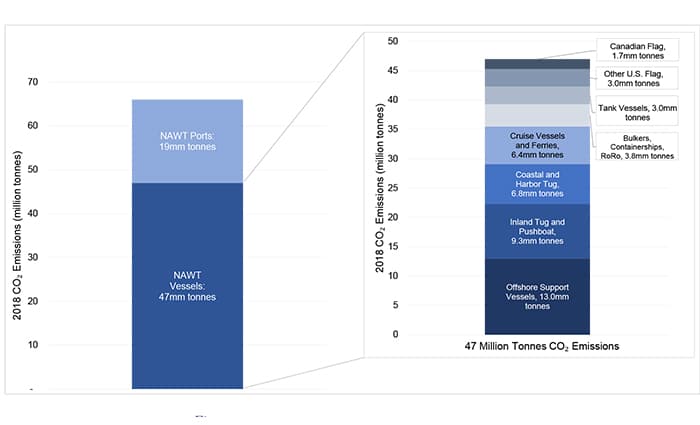The Houston-headquartered Blue Sky Maritime Coalition (BSMC) has released a new report that provides a benchmark for CO2 emissions from the major vessel sectors that make up domestic maritime transportation in North America . The coalition, a non-profit corporation, is a strategic alliance formed to accelerate the transition of North American waterborne transportation (NAWT) toward net-zero greenhouse gas (GHG) emissions and the study gives some insights into what’s needed to meet that goal.
“Having a complete view of the North American maritime industry’s carbon footprint helps us better understand the sum of the challenge ahead of us and the solutions needed to address those challenges. This report drills down to the sector level, helping us focus and prioritize our efforts where they can have the biggest impact,” said David Cummins, BSMC President and CEO.
 Emissions by vessel type
Emissions by vessel type
The report found that CO2 emissions from North American waterborne transportation (NAWT) was approximately 47 million tonnes in 2018. Of the total North American maritime-related emissions, the offshore support vessel fleet and the inland tug and push-boat fleets make up nearly 50 percent of all emissions. Coastal and harbor tugs and ferries make up another 14 percent, and tankers and articulated tug-barges contribute 6 percent.
“Establishing a baseline for emissions that considers operational variables and unique sector characteristics is an important step in being able to measure progress toward our decarbonization goals. Sharing this data is key to building collaboration and trust among our stakeholders and helps chart a path forward together,” continued Cummins.
The study draws some interesting conclusions. Among them:
Although the emissions reduction potential is significant, there is no existing commercial structure or agreement in place that aligns the interests of charterers, owners, and investors to decarbonize the NAWT business. The coalition says it is collaborating with leading decision makers in the industry to create such an arrangement.






